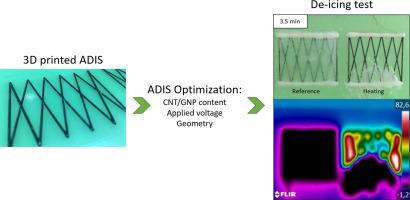当前位置:
X-MOL 学术
›
Eur. Polym. J.
›
论文详情
Our official English website, www.x-mol.net, welcomes your
feedback! (Note: you will need to create a separate account there.)
3D printed epoxy-CNTs/GNPs conductive inks with application in Anti-icing and De-Icing Systems
European Polymer Journal ( IF 5.8 ) Pub Date : 2020-12-01 , DOI: 10.1016/j.eurpolymj.2020.110090 A. Cortés , A. Jiménez-Suárez , M. Campo , A. Ureña , S.G. Prolongo
European Polymer Journal ( IF 5.8 ) Pub Date : 2020-12-01 , DOI: 10.1016/j.eurpolymj.2020.110090 A. Cortés , A. Jiménez-Suárez , M. Campo , A. Ureña , S.G. Prolongo

|
Abstract This paper studies the development and characterization of 3D printed conductive circuits based on epoxy inks doped with carbon nanotubes (CNTs) and/or graphene nanoplatelets (GNPs), which could be used in applications such as electronic circuits, heated seats, Anti-icing and De-Icing Systems (ADIS) or Structural Health Monitoring (SHM) systems, among others. A design of experiments (DOE) has been carried out by the Taguchi method to develop and optimize an ADIS based on a 3D printed circuit, using a conductive ink doped with CNTs/GNPs to achieve Joules heating. The target of the DOE is based on reaching the highest average temperature, which was measured by infrared thermographic analysis, taking also into account the quality of the 3D printed circuits. The DOE factors were the CNT and GNP content, the voltage applied to the circuit and its geometry, proposing two alternative designs. Finally, a de-icing test was carried out with the optimal parameters obtained from the DOE. Results evince the viability of the system developed, being able to melt an ice layer of 2.5 mm thick in 3 min and 30 s.
中文翻译:

应用于防冰和除冰系统的 3D 打印环氧树脂-CNTs/GNPs 导电油墨
摘要 本文研究了基于掺杂碳纳米管 (CNT) 和/或石墨烯纳米片 (GNP) 的环氧树脂油墨的 3D 印刷导电电路的开发和表征,该电路可用于电子电路、加热座椅、防结冰等应用。除冰系统 (ADIS) 或结构健康监测 (SHM) 系统等。已经通过田口方法进行了实验设计 (DOE),以开发和优化基于 3D 印刷电路的 ADIS,使用掺杂有 CNT/GNP 的导电墨水实现焦耳加热。DOE 的目标基于达到最高平均温度,这是通过红外热成像分析测量的,同时考虑了 3D 印刷电路的质量。DOE 因素是 CNT 和 GNP 含量,施加到电路的电压及其几何形状,提出了两种替代设计。最后,使用从 DOE 获得的最佳参数进行了除冰测试。结果表明所开发的系统具有可行性,能够在 3 分钟 30 秒内融化 2.5 毫米厚的冰层。
更新日期:2020-12-01
中文翻译:

应用于防冰和除冰系统的 3D 打印环氧树脂-CNTs/GNPs 导电油墨
摘要 本文研究了基于掺杂碳纳米管 (CNT) 和/或石墨烯纳米片 (GNP) 的环氧树脂油墨的 3D 印刷导电电路的开发和表征,该电路可用于电子电路、加热座椅、防结冰等应用。除冰系统 (ADIS) 或结构健康监测 (SHM) 系统等。已经通过田口方法进行了实验设计 (DOE),以开发和优化基于 3D 印刷电路的 ADIS,使用掺杂有 CNT/GNP 的导电墨水实现焦耳加热。DOE 的目标基于达到最高平均温度,这是通过红外热成像分析测量的,同时考虑了 3D 印刷电路的质量。DOE 因素是 CNT 和 GNP 含量,施加到电路的电压及其几何形状,提出了两种替代设计。最后,使用从 DOE 获得的最佳参数进行了除冰测试。结果表明所开发的系统具有可行性,能够在 3 分钟 30 秒内融化 2.5 毫米厚的冰层。











































 京公网安备 11010802027423号
京公网安备 11010802027423号